The Grand Wilcockson Tour to Derbyshire Day 8: The Planter, Tower of London and Westminster Abbey
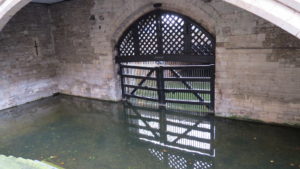
Copyright © Jane E. Wilcox, Forget-Me-Not Ancestry, Albany, NY www.4getmenotancestry.com.
In September 2017 I led a tour to Derbyshire, England, in search of my Puritan ancestors William Wilcockson and his wife Margaret. They came to New England on the Planter in 1635 with their two-year-old son John Wilcockson and Ann Harvie, whom I believe to be Margaret’s sister. They came during the Puritan Great Migration 1620-1640. With them on the Planter were Margaret’s first cousins Richard Harvie and his sister Mary Harvie with her husband William Beardsley and their three children Mary, John and infant Joseph. This homecoming trip with my cousins in 2017 culminated my research on the Wilcocksons of Biggin-by-Hulland, the Harvies of Ilkeston and their minister Rev. Adam Blakeman/Blackman (who founded Stratford, Conn. with them in 1639) that I undertook on three genealogy research trips to England between 2000 and 2015.
On this trip my cousins and I followed in the footsteps of Puritan William and Margaret Wilcockson (not spelled Wilcoxson as many have tried to modernize it) from their origins in Derbyshire, England, to their exposure to non-conformist ideas that eventually caused them to emigrate to America, to the churches they attended, to their dissenting Puritan network of family and friends, to their journey to the port of London to take passage on the Planter in 1635. While in England I sent daily emails to about 50 of my extended family and friends, as I had done in the past with the three other research trips, sharing our journey with them. The emails sent during the trip have been expanded and fact-checked to present here as blog posts. When you are reading my account of Puritan William in England, keep in mind that this is a proposed family of origin for William Wilcockson of Stratford, Conn. based on the evidence in the available records. Think “probable” and “probably” when you read Puritan William’s story.
Down the road I will write a series of articles giving the documentary evidence as to why I believe Puritan William was the son of tanner William Wilcockson and his first unknown wife from Biggin-by-Hulland, Derbyshire, and why Puritan William’s wife Margaret was Margaret Harvie, daughter of weaver James Harvie and his wife Elizabeth Winfield from Ilkeston Derbyshire — and not Margaret Birdseye or Birdsey as has long been erroneously held. These articles will contain more details and all of the sources I used to compile the evidence, as well as the genealogies of the Wilcockson, the Harvie and the Blakeman families in England in the 1500s and early 1600s.
Day 8
This is what we had planned for our first day in London:
- English breakfast at the hotel (St. Simeon in Kensington, BTW) at 7:45
- Depart the hotel at 8:30
- Tube (subway) to Tower Hill
- Tower of London at 9:30
- All Hallows Church (Saxon church) 11:30ish
- Walk over London Bridge to London Bridge Train Station to pick up a special ticket for tomorrow’s day trip, 20 minutes
- Get a fast lunch
- Tube from London Bridge Station to Westminster by 2:00
- Westminster Abbey to tour for an hour before it closed at 3:30
- Churchill’s War Room from 3:30 to 4:45 for some, later for others
- Evensong at Westminster at 5:00 for some
- Meet after Evensong for dinner
Here’s what we actually did:
- Breakfast at 7:45
- Arrived Tower of London at 9:20, toured until 1:45ish
- Lunch just outside the Tower
- Westminster 3:00 (and found that it’s open until 4:30)
- Evensong at Westminster 5:00
- Walking around Parliament
- Dinner near the hotel
So much for packing it all in.
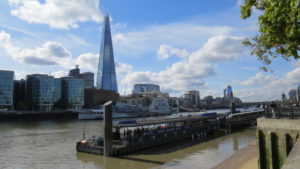
Looking toward London Bridge from the Tower of London. The Planter likely was anchored at this spot on the Thames, with the Customs House on the right bank of the river.
We finished the story of Wilcocksons today at the Tower of London (which is not really a single tower but a castle-fortress). After Puritan William Wilcockson and his extended family received their certificate from the minister at St Albans Cathedral (see Day 6), they made their way about 25 miles to the port of London to book passage on a ship. They ended up on the Planter.
Most of the larger ships were anchored out in the Thames River. The larger sea-faring vessels could only go so far up the Thames because London Bridge spanned the river just west of the Tower of London, blocking any larger ships from going up river. The Customs House was located between London Bridge and the Tower. Puritan William and Margaret on the Planter likely were anchored in the river just off the Tower of London — hence our journey there to end the Wilcockson story in England. The Thames from the Tower to the bridge looks a little different today than it did in Puritan William’s day.
The Customs House at the time Puritan William and Margaret were there in 1635 kept track of all the comings and goings of ships and people. Interestingly, London Bridge had buildings spanning its length across the Thames, which Puritan William and Margaret would have seen. If I remember the story correctly, the bridge caught on fire during the Great London Fire in the 1660s and that’s what took out the buildings on London Bridge. There are no buildings on the bridge now.
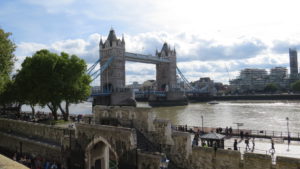
Tower Bridge from the Tower of London — nothing was there in 1635 when William and Margaret were in London.
When Puritan William and Margaret arrived in London in 1635, passengers ready for departure were rowed out to the ships in the river. The customs agents apparently went out to the ships to collect the certificates of conformity. Puritan William’s and Margaret’s names were entered into the customs house log book on April 2, 1635, along with their son John, Margaret’s possible sister Ann Harvie, the five Beardsleys, Richard Harvie and the one Tuttle brother (John) and his family from St Albans, Hertfordshire and others for a total of 38 people. The other two Tuttle brothers (Richard and William) and their families from Ringstead, Northamptonshire went separately to London and had a different certificate to present to the customs agent, so they were logged into the customs house book on a different date.
Puritan William and Margaret waited about two weeks for the Planter to have a full load of people. There were 118 passengers in all, plus a crew of about 50. They departed mid-April. Chet and I figured that the ships in the Thames must have used the current, the tide (the Thames is tidal, with what looks like a 15-ft. tide), and maybe sails to make their way the 100 or so miles to the English Channel. When I was at the Tower in 2002, the tide was high so I didn’t realize that the Thames was tidal. Today it was at low tide and we could see the obvious high tide marks.
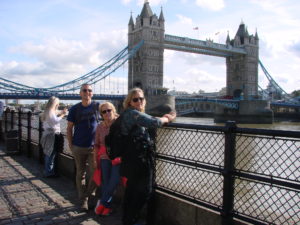
Tower Bridge. Photo by Chet Wilcox.
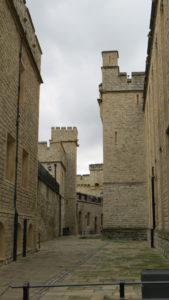 The Planter arrived in Boston Harbor on June 7 when Gov. John Winthrop wrote in his diary that seven ships had arrived on that day. From there they went to Concord, Mass. which was just being settled in the summer of 1635. From the 118 passengers on the Planter, only our Derbyshire families went to Concord. The others spread out throughout the Massachusetts Bay colony. (Even the Tuttle brothers and their families did not all go to one location.) The Derbyshire group waited in Concord three years for their beloved Derbyshire minister, Rev. Adam Blakeman, to arrive in New England. In that time a few more of Blakeman’s flock made their way across the ocean. In the spring of 1639 Blakeman and his English followers in New England and a few others already in Massachusetts founded what is now Stratford, Conn. – and that’s a whole other story!
The Planter arrived in Boston Harbor on June 7 when Gov. John Winthrop wrote in his diary that seven ships had arrived on that day. From there they went to Concord, Mass. which was just being settled in the summer of 1635. From the 118 passengers on the Planter, only our Derbyshire families went to Concord. The others spread out throughout the Massachusetts Bay colony. (Even the Tuttle brothers and their families did not all go to one location.) The Derbyshire group waited in Concord three years for their beloved Derbyshire minister, Rev. Adam Blakeman, to arrive in New England. In that time a few more of Blakeman’s flock made their way across the ocean. In the spring of 1639 Blakeman and his English followers in New England and a few others already in Massachusetts founded what is now Stratford, Conn. – and that’s a whole other story!
This ends the Wilcockson story in England for this Grand Wilcockson Tour to Derbyshire – until I tell it again in the articles, with all the evidence that I’ve compiled and all the sources.
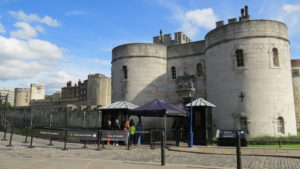 Now to the Tower of London for us. We had a guided tour from a Yeoman Warder who entertained us with jokes along the way. He was great! We saw the chapel, the crown jewels, the prisons (with graffiti from prisoners carved into the walls), the medieval living quarters, the White Tower, the zoo (no longer containing animals) and a lot more.
Now to the Tower of London for us. We had a guided tour from a Yeoman Warder who entertained us with jokes along the way. He was great! We saw the chapel, the crown jewels, the prisons (with graffiti from prisoners carved into the walls), the medieval living quarters, the White Tower, the zoo (no longer containing animals) and a lot more.
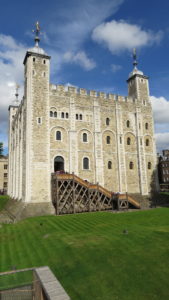
The White Tower, built by William the Conqueror, within the Tower of London.
The Tower was started by William the Conqueror, my ancestor. William had the White Tower built first, and it’s now in the center of the complex. The White Tower houses a display of armour that has been on display for a few centuries. Three or four floors (I lost count) are filled with wooden horses, kings’ armour, and such. The Tower was even built with indoor latrines, which we got to see too.
The prison at the Tower held many famous and infamous people. Queen Elizabeth was held here as a princess when her sister, Queen Mary, suspected Elizabeth of plotting against her. Elizabeth’s mother, Anne Boleyn, was beheaded at the Tower, as was Henry VIII’s fifth unfaithful wife, Catherine Howard. Other prisoners was not as lucky as the two queens. Those convicted of treason were hanged until short of death, drawn, eviscerated, quartered and then beheaded. Their heads were then put on spikes that were placed on the Tower Bridge as a warning to all.
The medieval living quarters are what my ancestor Henry III added to the Tower. His 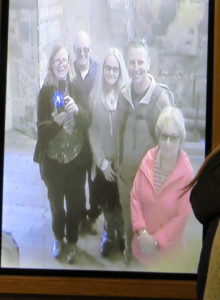 son Edward I is my first royal ancestor (on my mom’s side). I descend from Edward I’s (a.k.a. Longshanks because he was so tall) daughter Joan of Acre, who was born in 1272 in what is now Israel when her mother Eleanor of Castille insisted on going with her husband Edward Longshanks to the Crusades. Joan also gets me back to William the Conqueror and Charlemagne. Going back a few generations, I also have a number of nobles who signed Magna Charta in 1215, plus King John whom they signed against. My maternal grandmother Hattie found the gateway ancestor when I was a teenager and I started researching and accumulating nobility — almost all of whom I have now forgotten. The gateway ancestors were Jane Basset and her daughter Frances Deighton. Frances came with the Puritan Great Migration to New England in the 1630s.
son Edward I is my first royal ancestor (on my mom’s side). I descend from Edward I’s (a.k.a. Longshanks because he was so tall) daughter Joan of Acre, who was born in 1272 in what is now Israel when her mother Eleanor of Castille insisted on going with her husband Edward Longshanks to the Crusades. Joan also gets me back to William the Conqueror and Charlemagne. Going back a few generations, I also have a number of nobles who signed Magna Charta in 1215, plus King John whom they signed against. My maternal grandmother Hattie found the gateway ancestor when I was a teenager and I started researching and accumulating nobility — almost all of whom I have now forgotten. The gateway ancestors were Jane Basset and her daughter Frances Deighton. Frances came with the Puritan Great Migration to New England in the 1630s.
In the photo to the below, see me claiming my inheritance to the throne in Edward I’s quarters at the Tower of London. I 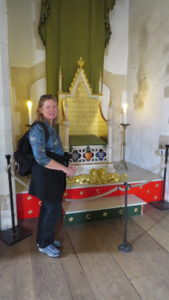 haven’t spent much time on my royal ancestors because the others are much more fun to research, but today I bought a book on the Plantagenets that looks like a fun book that will tell me more about them. [P.S. I have since read the book, and it’s great. It’s called The Plantagenets: The Kings Who Made England by Dan Jones. He is a wonderful storyteller, bringing the Plantagenet kings and queens (I forgot about my ancestor Empress Matilda whose husband Geoffrey Plantagenet gave them their name) to life and telling history in a non-academic way.]
haven’t spent much time on my royal ancestors because the others are much more fun to research, but today I bought a book on the Plantagenets that looks like a fun book that will tell me more about them. [P.S. I have since read the book, and it’s great. It’s called The Plantagenets: The Kings Who Made England by Dan Jones. He is a wonderful storyteller, bringing the Plantagenet kings and queens (I forgot about my ancestor Empress Matilda whose husband Geoffrey Plantagenet gave them their name) to life and telling history in a non-academic way.]
On to Westminster. When I went to Westminster Abbey for Evensong on a previous trip to London for research, it was in January or February and it was dark at 5:00pm when Evensong is held. That night I climbed out of the Tube stairs onto the street level and practically ran right smack into Big Ben, Parliament and Westminster Abbey all lit up for the evening. My mouth dropped when I realized what I was looking at. Wow! I told Chet and Pat that I had had a Wow! experience the last time coming out of the Tube, but I didn’t tell them what they’d see. What they saw were two trucks and a bus nose to tail blocking the view and Big Ben surrounded by scaffolding for renovations. It was decidedly un-wow for them. How disappointing!
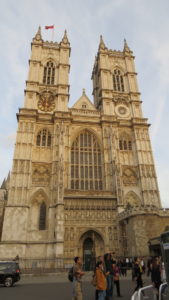 We arrived at Westminster Abbey with enough time to do the audio tour. Westminster is where the all the kings and queens of England have been coronated since my ancestor William the Conqueror in 1066. It’s also where many monarchs and other notables are buried.
We arrived at Westminster Abbey with enough time to do the audio tour. Westminster is where the all the kings and queens of England have been coronated since my ancestor William the Conqueror in 1066. It’s also where many monarchs and other notables are buried.
When I was at Westminster for Evensong on the last trip, I couldn’t see any of the monuments in the abbey at the time because it was closed except for the area where Evensong is prayed (the Quire) and there were no lights in the abbey except for the way to and in the Quire. I was intrigued with the memorials that I couldn’t get close to then and could barely see because of the darkness. It was quite eerie! This time I was on a mission to see Elizabeth I’s tomb, and I did. Her effigy is in a separate chamber where she was buried with her sister Queen Mary in the same tomb. I also saw the tombs of my ancestors Edward I and Henry III. (Most of my ancestors before them were buried elsewhere.) The monarchs’ monuments were impressive, but it wasn’t the kings and queens that got me at Westminster.
The Poet’s Corner is the last section of the memorials on the audio tour. (Westminster has tombs and memorials for scientists, military, nobles and others as well as the kings and queens.) I found Chaucer’s tomb first. Then I turned around and found that I was standing on the memorials to D.H. Lawrence, Alfred Lord Tennyson, and others. I started to cry at that point. I had lived and breathed their words for so many years up to the time I was an English lit major in college, and it all came flooding back to me at that moment. These were the ones who had touched me the most. It was quite an experience standing among the bards at Westminster.
The abbey closes to visitors before Evensong, so Barry went to the gift shop and Chet, Marilyn, Pat and I wandered to other sections that were still open — like the oldest known chapel at Westminster. Barry was going to meet up with us in the Evensong queue. We meandered a little too long and the Evensong line was already starting to go in. We got to the back of the line and eventually were ushered to our seats. No sign of Barry at any point along the way. We looked across the sea of people for him. No Barry. I commented jokingly that he probably was in the Choir seats. At one point Chet poked me and asked if Barry was on the monitor that was broadcasting the Choir near us. I couldn’t tell, but at the end when the Choir had departed, sure enough. There was Barry on the monitor, sitting in the Choir seats. He couldn’t get into the gift shop and went to join us in line. He couldn’t find us so he got in line. He was 10th in line — and got to sit in the Choir seats for Evensong!
I didn’t appreciate this Evensong as much as I did the other Evensongs I have attended in my three previous trips. The 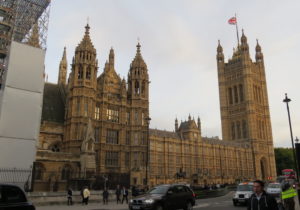 choirmaster chose 20th century music which is not to my taste — too discordant! After Evensong we walked down the block to look at Parliament — beautifully sunlit from the setting sun. Since Big Ben is under renovation there were no gongs for the hour.
choirmaster chose 20th century music which is not to my taste — too discordant! After Evensong we walked down the block to look at Parliament — beautifully sunlit from the setting sun. Since Big Ben is under renovation there were no gongs for the hour.
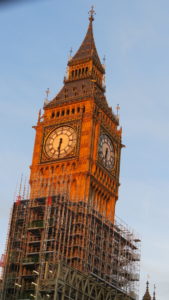 For dinner we went to a Lebanese restaurant near the hotel. It’s hard to find good British fare in Britain these days! Plus we’re testing Chet’s palate. We had a sampler with hummus, baba ganoush, and labne (kind of minty and yogurty) plus a chicken shish taouka. He liked both the Indian and the Lebanese in London.
For dinner we went to a Lebanese restaurant near the hotel. It’s hard to find good British fare in Britain these days! Plus we’re testing Chet’s palate. We had a sampler with hummus, baba ganoush, and labne (kind of minty and yogurty) plus a chicken shish taouka. He liked both the Indian and the Lebanese in London.
Tomorrow is our last full day in England. See you then!
Cheers!
Posted on by Jane Wilcox

2 thoughts on “The Grand Wilcockson Tour to Derbyshire Day 8: The Planter, Tower of London and Westminster Abbey”